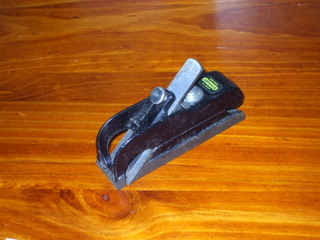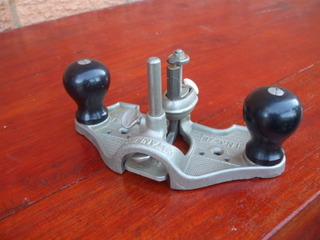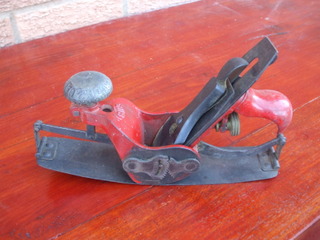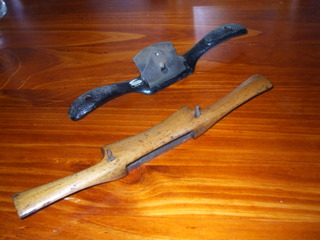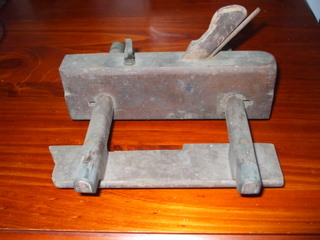Bull-Nosed Planes
Quite a number of planes were designed so that the blade was situated toward the front of the sole, in other words you could plane into a corner. If the blade was covered by part of the plane body, the plane is “bull-nosed”, if the blade projects out to the sides of the body it is a rebate plane. The photo is one type of bull-nosed rebate plane, in a block plane size and style. The sizes ranged from the little one shown, up to ones almost the size of a jack plane (no.5). There was a variation where the bull-nose was disregarded and the blade was fixed straight to the toe and in theory it would plane right into the very corner.
Router Plane
Before the advent of the power router, tradesmen depended on the router plane (or Granny’s Tooth), it is a very simple plane that was capable of very accurate work. It was designed to level the bottom of trenches, mortises, sockets, grooves etc. It had a blade that was bent at right angles, was very thick in section, and extremely rigid. This would plane the top off any projections after the critical work had been done. Blades came in a number of widths – ¼”, 3/8” and ½” being the most common. While most blades were normal, i.e. at right angles to the side, some were ground at 45° to each side, similar to a plough share. Blades are still available and you can occasionally pick up entire planes.
You can extend the capability of a router plane by screwing the body to a wide board, then it is capable of bridging any gap and most are pre-drilled just for this purpose.
The Compass (or Circular) Plane
The compass plane is a very useful, though somewhat limited addition to the toolbox. When properly sharpened and adjusted the compass plane will make precise curves ( either convex or concave) in wood. Moreover it will stop once you have achieved the desired curve. Unfortunately this comes at a price – due to the nature of wood, on any curve you will be planning against the grain at some point. In other words, you will have to plane from both ends if you wish to achieve a smooth and accurate finish. This is not a fault of the plane so much as it is the nature of wood. The problem can be overcome – to a degree – by sharpening the blade to a razor edge. The big advantage of the compass plane over the spokeshave (see later) is that it is far more easily controllable. It is not so likely to chatter (bounce up and down and leave ridges) and it will give a more even curve, if that is what you want. I doubt that I would use my compass plane more than once a year, but I still regard it as irreplaceable.
The Spokeshave
The spokeshave is, as the name suggests, a plane for shaving spokes! In “the good old days” they were used by wheelwrights and such for rounding timber. Spokeshaves come in two types and two versions.
Firstly, there is the wooden Spokeshave, they comprise a body made from a single piece of wood , a a blade that is usually referred to as the “iron”, (as are most plane blades for that matter). In the days of yore, a wooden Spokeshave was adjusted with a hammer, the tangs being tapped to force the blade through the stock to the desired setting. They were a good tool but suffered limitations, the tanks would wear away the wood surrounding them and they were forever loosening up.
The wooden stock was followed by the metal stock. To my mind this was a great advance, as it used a different type of blade, a different style of blade locking and a different method of blade adjustment. I own two metal spokeshaves but wouldn’t with a wooden one unless it was for collection purposes.
The metal Spokeshave has a blade and a variation on the level cap iron, it also has two thumbscrews for adjusting it (if it is one of the more expensive versions). Many cheap models were made without the thumbscrew adjustments; they were adjusted with a hammer and did a fine job.
The two versions of spokeshaves are round and flat. The “flat” is designed for planing in either a straight line or on a convex surface but it could also be used on larger concave depressions.
The “round” Spokeshave will cut straight or flat surfaces but is designed to cut concave curves in timber. The “flat” has a flat sole and the “round” has a round sole. You can easily modify a “flat” into a “round” with the aid of a file. The round version is not quite as easy to use, as it requires more hand control to prevent the body from tipping forward. As with the compass plane you have to plane with the grain – which means planing from both ends.
Rebate Planes
Rebate (or Rabbet) planes are planes designed to cut a recess in wood. If the recess is along the grain and on an edge, it is a rebate, if it is across the grain and on an edge it is a trench, if it is away from the edge it is a groove.
As a rule, rebate planes will plane both rebates and trenches, the planing of a trench (going across the grain) requires that the plane should possess a spur, or small blade, just in front of the plane iron. The spur cuts the wood fibres and prevents the iron from tearing at the edge of the cut. It has been my experience that many spur cutters are missing from the rebate planes, however they are cheap to buy and you can always modify a spur to do the job. Personally, I like to use the spur whether I am cutting rebates or trenches. Also, don’t forget to sharpen the spur (on the inner side only) if you want a clean cut edge.
Fillister Planes
Once upon a time (up to the last war) you could buy sets of wooden moulding planes, these were a wooden plane on which the sole had been specially shaped. The blade was cut to a similar shape and the plane produced a moulding – such as would be found on the older door frames etc.
The only real problem with the wooden moulding planes was that you needed a toolbox full if you wished to cut many different sizes or shapes. This problem was overcome by the fillister plane, with my plane I have about 60 different blades and in old catalogues I have seen ads for over a hundred different blades.
The fillister must be one of the most useful special purpose blades that you can buy and I would strongly suggest you buy one if you ever get the opportunity. If there are no blades with it, and they do get lost, remember that you still may be able to buy spare blades from larger or woodworking specialist tool shops. If necessary you could always buy rebating blades and grind the required profile yourself.
The fillister is one of the very few ways of making up ornamental moulding for picture frames etc. You can no longer buy any decent selection of framing and if you can’t do it yourself you go without. If you should have the opportunity of buying up old wooden moulding planes at a reasonable price you should do so. From time to time I have bought then for a dollar or two, sometimes split, frequently with pieces missing and depending upon the tool I frequently buy them just for the wood content.
Usually they are English beech although I have a couple that are oak, they can be cut up to make new wedges for better planes with missing parts. The timber will be similar, and if you have a genuine antique plane it is acceptable to make replacement parts form a similar timber of the same age. You can also turn the timber in a lathe to make up small tool handles etc. so for the same reasons, should you get the chance, wooden jack planes and trying planes have a lot of timber in the body.
A bit about Sharpening Stones
When you start using special purpose planes you will find a real need for proper sharpening facilities, but suffice to say at this point that if you get the chance to buy up old oil stones, then do so because from my (rather biased) point of view, modern oil stones are rubbish. You just can’t seem to buy decent fine stone, they are all far too coarse, the older stones are usually far smoother and for mine, give a much better cut. Buy up slips too, if you can. Slips are thin stones with rounded edges - you need them to sharpen curves.
By Bill Tarplee



